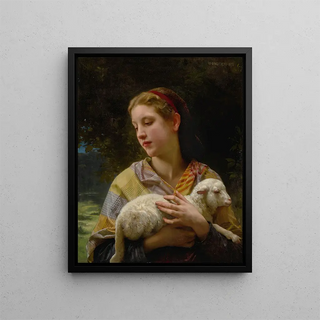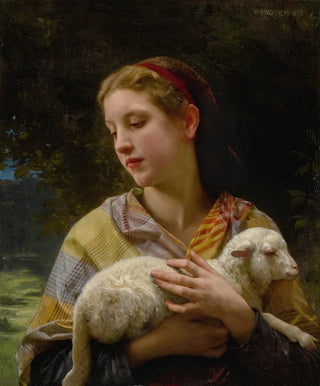Art print | Innocence - William Bouguereau


View from behind

Frame (optional)
William Bouguereau's "Innocence" art print is a true masterpiece embodying the essence of beauty and purity. This painting, created at the end of the 19th century, transports viewers into a universe filled with tenderness and serenity. The depiction of a young girl, surrounded by symbols of innocence, evokes a palpable emotion and nostalgia for a bygone era. Bouguereau, with his exceptional mastery of light and color, manages to capture the very soul of childhood, offering a reflection on the fragility and beauty of this life stage. The art print of this work allows for rediscovering the intensity of this emotion and adding a touch of refinement to any interior.
Style and uniqueness of the work
Bouguereau's style is characterized by striking realism and meticulous attention to detail. In "Innocence," the delicate features of the young girl's face, as well as the texture of her clothing, demonstrate his technical skill. The artist skillfully plays with light, creating soft shadows that enhance the depth and dimension of the scene. The colors, subtly nuanced, evoke a peaceful and dreamy atmosphere, inviting the viewer to immerse themselves in the universe of the artwork. The composition is carefully orchestrated, with each element placed to guide the gaze toward the expressive face of the child. This ability to create an emotional connection with the audience makes Bouguereau an undisputed master of his era, and "Innocence" is the perfect illustration of this.
The artist and his influence
William Bouguereau, born in 1825, is one of the most emblematic painters of the French academic movement. His career, marked by numerous distinctions, testifies to the impact he had on his contemporaries and future generations. Bouguereau successfully combined tradition and innovation, reinterpreting classical themes with a modern sensibility. His influence is still felt today, both in the art world and in popular culture. Contemporary artists draw inspiration from his approach to realism.

Matte finish

View from behind

Frame (optional)
William Bouguereau's "Innocence" art print is a true masterpiece embodying the essence of beauty and purity. This painting, created at the end of the 19th century, transports viewers into a universe filled with tenderness and serenity. The depiction of a young girl, surrounded by symbols of innocence, evokes a palpable emotion and nostalgia for a bygone era. Bouguereau, with his exceptional mastery of light and color, manages to capture the very soul of childhood, offering a reflection on the fragility and beauty of this life stage. The art print of this work allows for rediscovering the intensity of this emotion and adding a touch of refinement to any interior.
Style and uniqueness of the work
Bouguereau's style is characterized by striking realism and meticulous attention to detail. In "Innocence," the delicate features of the young girl's face, as well as the texture of her clothing, demonstrate his technical skill. The artist skillfully plays with light, creating soft shadows that enhance the depth and dimension of the scene. The colors, subtly nuanced, evoke a peaceful and dreamy atmosphere, inviting the viewer to immerse themselves in the universe of the artwork. The composition is carefully orchestrated, with each element placed to guide the gaze toward the expressive face of the child. This ability to create an emotional connection with the audience makes Bouguereau an undisputed master of his era, and "Innocence" is the perfect illustration of this.
The artist and his influence
William Bouguereau, born in 1825, is one of the most emblematic painters of the French academic movement. His career, marked by numerous distinctions, testifies to the impact he had on his contemporaries and future generations. Bouguereau successfully combined tradition and innovation, reinterpreting classical themes with a modern sensibility. His influence is still felt today, both in the art world and in popular culture. Contemporary artists draw inspiration from his approach to realism.






